
N.S.B. Cosmic Center

Literary Adventures
This page will take you into pieces of literature that are carefully selected for their great content at the literary, scientific, or philosophical level. A short selection will be presented in full. A long one will be divided into sections that will be refreshed regularly. Emphasis and highlights are mostly ours, not made by the original author.
Here is our current selection:
The Fairy-Land of Science (1878) by Arabella Burton Buckley
Lecture 9.
Bees in the Hive
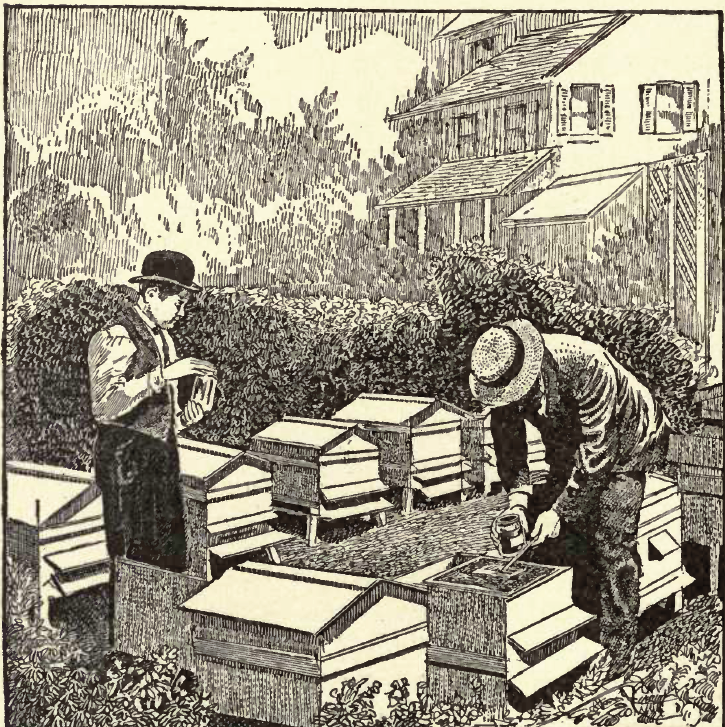
I am going to ask you to visit with me today one of the most wonderful cities in the world. It is a city with no human beings in it, and yet it is densely populated, for such a city may contain from twenty thousand to sixty thousand inhabitants. In it you will find streets, but no pavements, for the inhabitants walk along the walls of the houses; while in the houses you will see no windows, for each house just fits its owner, and the door is the only opening in it. Though made without hands these houses are most evenly and regularly built in tiers one above the other; and here and there a few royal palaces, larger and more spacious than the rest, catch the eye conspicuously as they stand out at the corners of the streets.
Some of the ordinary houses are used to live in, while others serve as storehouses where food is laid up in the summer to feed the inhabitants during the winter, when they are not allowed to go outside the walls. Not that the gates are ever shut: that is not necessary, for in this wonderful city each citizen follows the laws; going out when it is time to go out, coming home at proper hours, and staying at home when it is his or her duty. And in the winter, when it is very cold outside, the inhabitants, having no fires, keep themselves warm within the city by clustering together, and never venturing out of doors.
One single queen reigns over the whole of this numerous population, and you might perhaps fancy that, having so many subjects to work for her and wait upon her, she would do nothing but amuse herself. On the contrary, she too obeys the laws laid down for her guidance, and never, except on one or two state occasions, goes out of the city, but works as hard as the rest in performing her own royal duties.
From sunrise to sunset, whenever the weather is fine, all is life, activity, and bustle in this busy city. Though the gates are so narrow that two inhabitants can only just pass each other on their way through them, yet thousands go in and out every hour of the day; some bringing in materials to build new houses, others food and provisions to store up for the winter; and while all appears confusion and disorder among this rapidly moving throng, yet in reality each has her own work to do, and perfect order reigns over the whole.
Even if you did not already know from the title of the lecture what city this is that I am describing, you would no doubt guess that it is a beehive. For where in the whole world, except indeed upon an anthill, can we find so busy, so industrious, or so orderly a community as among the bees? More than a hundred years ago, a blind naturalist, François Huber, set himself to study the habits of these wonderful insects, and with the help of his wife and an intelligent man-servant managed to learn most of their secrets. Before his time all naturalists had failed in watching bees, because if they put them in hives with glass windows, the bees, not liking the light, closed up the windows with cement before they began to work. But Huber invented a hive which he could open and close at will, putting a glass hive inside it, and by this means he was able to surprise the bees at their work. Thanks to his studies, and to those of other naturalists who have followed in his steps, we now know almost as much about the home of bees as we do about our own; and if we follow out today the building of a bee-city and the life of its inhabitants, I think you will acknowledge that they are a wonderful community, and that it is a great compliment to anyone to say that he or she is "as busy as a bee."
In order to begin at the beginning of the story, let us suppose that we go into a country garden one fine morning in May when the sun is shining brightly overhead, and that we see hanging from the bough of an old apple-tree a black object which looks very much like a large plum-pudding. On approaching it, however, we see that it is a large cluster or swarm of bees clinging to each other by their legs; each bee with its two fore-legs clinging to the two hinder legs of the one above it. In this way as many as 20,000 bees may be clinging together, and yet they hang so freely that a bee, even from quite the centre of the swarm, can disengage herself from her neighbours and pass through to the outside of the cluster whenever she wishes.
If these bees were left to themselves, they would find a home after a time in a hollow tree, or under the roof of a house, or in some other cavity, and begin to build their honeycomb there. But as we do not wish to lose their honey we will bring a hive, and, holding it under the swarm, shake the bough gently so that the bees fall into it, and cling to the sides as we turn it over on a piece of clean linen, on the stand where the hive is to be.
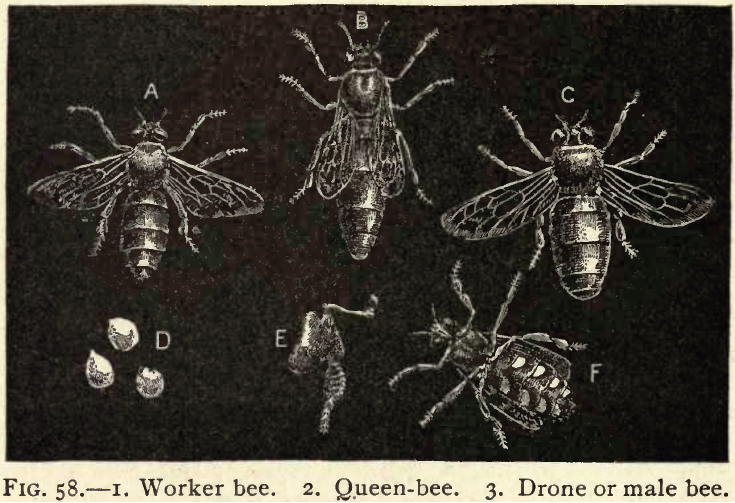
And now let us suppose that we are able to watch what is going on in the hive. Before five minutes are over the industrious little insects have begun to disperse and to make arrangements in their new home. A number (perhaps about two thousand) of large, lumbering bees of a darker colour than the rest, will, it is true, wander aimlessly about the hive, and wait for the others to feed them and house them; but these are the drones, or male bees (3, Fig. 58), who never do any work except during one or two days in their whole lives. But the smaller working bees (1, Fig. 58) begin to be busy at once. Some fly off in search of honey. Others walk carefully all round the inside of the hive to see if there are any cracks in it; and if there are, they go off to the horse-chestnut trees, poplars, hollyhocks, or other plants which have sticky buds, and gather a kind of gum called "propolis," with which they cement the cracks and make them air-tight. Others again, cluster round one bee (2, Fig. 58) blacker than the rest and having a longer body and shorter wings; for this is the queen-bee, the mother of the hive, and she must be watched and tended.
But the largest number begin to hang in a cluster from the roof just as they did from the bough of the apple tree. What are they doing there? Watch for a little while and you will soon see one bee come out from among its companions and settle on the top of the inside of the hive, turning herself round and round, so as to push the other bees back, and to make a space in which she can work. Then she will begin to pick at the under part of her body with her fore-legs, and will bring a scale of wax from a curious sort of pocket under her abdomen. Holding this wax in her claws, she will bite it with her hard, pointed upper jaws, which move to and fro sideways like a pair of pincers, then, moistening it with her tongue into a kind of paste, she will draw it out like a ribbon and plaster it on the top of the hive.
After that she will take another piece; for she has eight of these little wax-pockets, and she will go on till they are all exhausted. Then she will fly away out of the hive, leaving a small wax lump on the hive ceiling or on the bar stretched across it; then her place will be taken by another bee who will go through the same manoeuvres. This bee will be followed by another, and another, till a large wall of wax has been built, hanging from the bar of the hive as in Fig. 59, only that it will not yet have cells fashioned in it.
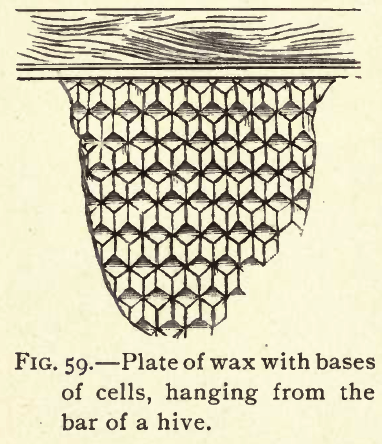
Meanwhile the bees which have been gathering honey out of doors begin to come back laden. But they cannot store their honey, for there are no cells made yet to put it in; neither can they build combs with the rest, for they have no wax in their wax-pockets. So they just go and hang quietly on to the other bees, and there they remain for twenty-four hours, during which time they digest the honey they have gathered, and part of it forms wax and oozes out from the scales under their body. Then they are prepared to join the others at work and plaster wax on to the hive.
And now, as soon as a rough lump of wax is ready, another set of bees come to do their work. These are called the nursing bees, because they prepare the cells and feed the young ones. One of these bees, standing on the roof of the hive, begins to force her head into the wax, biting with her jaws and moving her head to and fro. Soon she has made the beginning of a round hollow, and then she passes on to make another, while a second bee takes her place and enlarges the first one. As many as twenty bees will be employed in this way, one after another, upon each hole before it is large enough for the base of a cell.
Meanwhile another set of nursing bees have been working just in the same way on the other side of the wax, and so a series of hollows are made back to back all over the comb. Then the bees form the walls of the cells, and soon a number of six-sided tubes, about half an inch deep, stand all along each side of the comb ready to receive honey or bee-eggs.
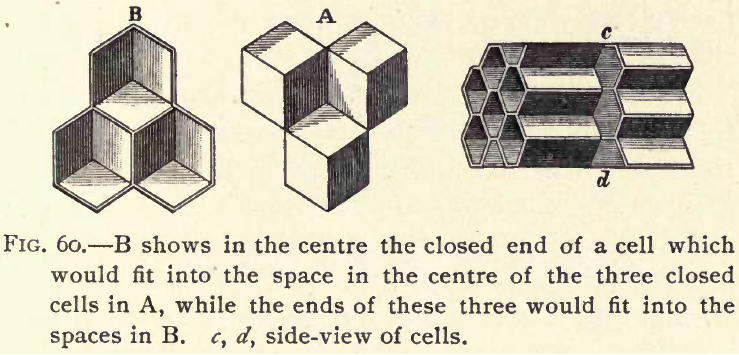
You can see the shape of these cells in c, d, Fig. 60, and notice how closely they fit into each other. Even the ends are so shaped that, as they lie back to back, the bottom of one cell (B, Fig. 60) fits into the space between the ends of three cells meeting it from the opposite side (A, Fig. 60), while they fit into the spaces around it. Upon this plan the clever little bees fill every atom of space, use the least possible quantity of wax, and make the cells lie so closely together that the whole comb is kept warm when the young bees are in it.
There are some kinds of bees who do not live in hives, but each one builds a home of its own. These bees--such as the upholsterer bee, which digs a hole in the earth and lines it with flowers and leaves, and the mason bee, which builds in walls--do not make six-sided cells, but round ones, for room is no object to them. But nature has gradually taught the little hive-bee to build its cells more and more closely, till they fit perfectly within each other. If you make a number of round holes close together in a soft substance, and then squeeze the substance evenly from all sides, the rounds will gradually take a six-sided form, showing that this is the closest shape into which they can be compressed. Although the bee does not know this, yet as she gnaws away every bit of wax that can be spared she brings the holes into this shape.
As soon as one comb is finished, the bees begin another by the side of it, leaving a narrow lane between, just broad enough for two bees to pass back to back as they crawl along, and so the work goes on till the hive is full of combs.
As soon, however, as a length of about five or six inches of the first comb has been made into cells, the bees which are bringing home honey no longer hang to make it into wax, but begin to store it in the cells. We all know where the bees go to fetch their honey, and how, when a bee settles on a flower, she thrusts into it her small tongue-like proboscis, which is really a lengthened under-lip, and sucks out the drop of honey. This she swallows, passing it down her throat into a honey-bag or first stomach, which lies between her throat and her real stomach, and when she gets back to the hive she can empty this bag and pass the honey back through her mouth again into the honey-cells.
But if you watch bees carefully, especially in the spring-time, you will find that they carry off something else besides honey. Early in the morning, when the dew is on the ground, or later in the day, in moist, shady places, you may see a bee rubbing itself against a flower, or biting those bags of yellow dust or pollen which we mentioned in Lecture VII. When she has covered herself with pollen, she will brush it off with her feet, and, bringing it to her mouth, she will moisten and roll it into a little ball, and then pass it back from the first pair of legs to the second and so to the third or hinder pair. Here she will pack it into a little hairy groove called a "basket" in the joint of one of the hind legs, where you may see it, looking like a swelled joint, as she hovers among the flowers. She often fills both hind legs in this way, and when she arrives back at the hive the nursing bees take the lumps from her, and eat it themselves, or mix it with honey to feed the young bees; or, when they have any to spare, store it away in old honey-cells to be used by-and-by. This is the dark, bitter stuff called "bee-bread" which you often find in a honeycomb, especially in a comb which has been filled late in the summer.
When the bee has been relieved of the bee-bread she goes off to one of the clean cells in the new comb, and, standing on the edge, throws up the honey from the honey-bag into the cell. One cell will hold the contents of many honey-bags, and so the busy little workers have to work all day filling cell after cell, in which the honey lies uncovered, being too thick and sticky to flow out, and is used for daily food--unless there is any to spare, and then they close up the cells with wax to keep for the winter.
Meanwhile, a day or two after the bees have settled in the hive, the queen-bee begins to get very restless. She goes outside the hive and hovers about a little while, and then comes in again, and though generally the bees all look very closely after her to keep her indoors, yet now they let her do as she likes. Again she goes out, and again back, and then, at last, she soars up into the air and flies away. But she is not allowed to go alone. All the drones of the hive rise up after her, forming a guard of honour to follow her wherever she goes.
In about half-an-hour she comes back again, and then the working bees all gather round her, knowing that now she will remain quietly in the hive and spend all her time in laying eggs: for it is the queen-bee who lays all the eggs in the hive. This she begins to do about two days after her flight. There are now many cells ready besides those filled with honey: and, escorted by several bees, the queen-bee goes to one of these, and, putting her head into it, remains there a second as if she were examining whether it would make a good home for the young bee. Then, coming out, she turns round and lays a small, oval, bluish-white egg in the cell. After this she takes no more notice of it, but goes on to the next cell and the next, doing the same thing, and laying eggs in all the empty cells equally on both sides of the comb. She goes on so quickly that she sometimes lays as many as 200 eggs in one day.
Then the work of the nursing bees begins. In two or three days each egg has become a tiny maggot or larva, and the nursing bees put into its cell a mixture of pollen and honey which they have prepared in their own mouths, thus making a kind of sweet bath in which the larva lies. In five or six days the larva grows so fat upon this that it nearly fills the cell, and then the bees seal up the mouth of the cell with a thin cover of wax, made of little rings and with a tiny hole in the centre.
As soon as the larva is covered in, it begins to give out from its under-lip a whitish, silken film, made of two threads of silk glued together, and with this it spins a covering or cocoon all round itself, and so it remains for about ten days more. At last, just twenty-one days after the egg was laid, the young bee is quite perfect, lying in the cell as in Fig. 61, and she begins to eat her way through the cocoon and through the waxen lid, and scrambles out of her cell. Then the nurses come again to her, stroke her wings and feed her for twenty-four hours, and after that she is quite ready to begin work, and flies out to gather honey and pollen like the rest of the workers.
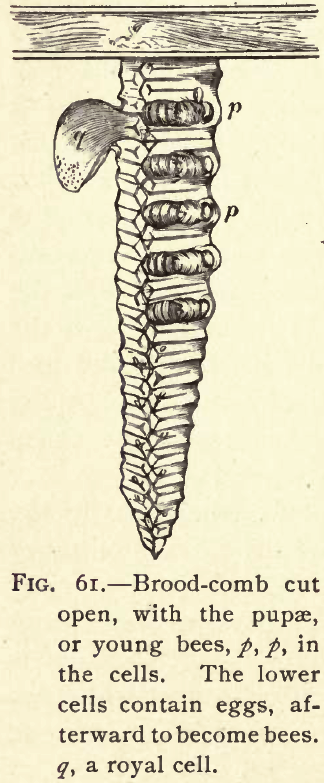
By this time the number of working bees in the hive is becoming very great, and the storing of honey and pollen-dust goes on very quickly. Even the empty cells which the young bees have left are cleaned out by the nurses and filled with honey; and this honey is darker than that stored in clean cells, and which we always call "virgin honey" because it is so pure and clear.
At last, after six weeks, the queen leaves off laying worker-eggs, and begins to lay, in some rather larger cells, eggs from which drones, or male bees, will grow up in about twenty days. Meanwhile the worker-bees have been building on the edge of the cones some very curious cells (q, Fig. 61) which look like thimbles hanging with the open side upwards, and about every three days the queen stops in laying drone-eggs and goes to put an egg in one of these cells. Notice that she waits three days between each of these peculiar layings, because we shall see presently that there is a good reason for her doing so.
The nursing bees take great care of these eggs, and instead of putting ordinary food into the cell, they fill it with a sweet, pungent jelly, for this larva is to become a princess and a future queen-bee. Curiously enough, it seems to be the peculiar food and the size of the cell which makes the larva grow into a mother-bee which can lay eggs, for if a hive has the misfortune to lose its queen, they take one of the ordinary worker-larvae and put it into a royal cell and feed it with jelly, and it becomes a queen-bee. As soon as the princess is shut in like the others, she begins to spin her cocoon, but she does not quite close it as the other bees do, but leaves a hole at the top.
At the end of sixteen days after the first royal egg was laid, the eldest princess begins to try to eat her way out of her cell, and about this time the old queen becomes very uneasy, and wanders about distractedly. The reason of this is, that there can never be two queen-bees in one hive, and the queen knows that her daughter will soon be coming out of her cradle and will try to turn her off her throne. So, not wishing to have to fight for her kingdom, she makes up her mind to seek a new home and take a number of her subjects with her. If you watch the hive about this time you will notice many of the bees clustering together after they have brought in their honey, and hanging patiently, in order to have plenty of wax ready to use when they start, while the queen keeps a sharp look-out for a bright, sunny day, on which they can swarm: for bees will never swarm on a wet or doubtful day if they can possibly help it, and we can easily understand why, when we consider how the rain would clog their wings and spoil the wax under their bodies.
Meanwhile the young princess grows very impatient, and tries to get out of her cell, but the worker-bees drive her back, for they know there would be a terrible fight if the two queens met. So they close up the hole she has made with fresh wax after having put in some food for her to live upon till she is released.
At last a suitable day arrives, and about ten or eleven o'clock in the morning the old queen leaves the hive, taking with her about 2000 drones and from 12,000 to 20,000 worker-bees, which fly a little way clustering round her till she alights on the bough of some tree, and then they form a compact swarm ready for a new hive or to find a home of their own.
Leaving them to go their way, we will now return to the old hive. Here the liberated princess is reigning in all her glory; the worker-bees crowd round her, watch over her, and feed her as though they could not do enough to show her honour. But still she is not happy. She is restless, and runs about as if looking for an enemy, and she tries to get at the remaining royal cells where the other young princesses are still shut in. But the workers will not let her touch them, and at last she stands still and begins to beat the air with her wings and to tremble all over, moving more and more quickly, till she makes quite a loud, piping noise.
Hark! What is that note answering her? It is a low, hoarse sound, and it comes from the cell of the next eldest princess. Now we see why the young queen has been so restless. She knows her sister will soon come out, and the louder and stronger the sound becomes within the cell, the sooner she knows the fight will have to begin. And so she makes up her mind to follow her mother's example and to lead off a second swarm. But she cannot always stop to choose a fine day, for her sister is growing very strong and may come out of her cell before she is off. And so the second, or after swarm, gets ready and goes away. And this explains why princesses' eggs are laid a few days apart, for if they were laid all on the same day, there would be no time for one princess to go off with a swarm before the other came out of her cell. Sometimes, when the workers are not watchful enough, two queens do meet, and then they fight till one is killed; or sometimes they both go off with the same swarm without finding each other out. But this only delays the fight till they get into the new hive; sooner or later one must be killed.
And now a third queen begins to reign in the old hive, and she is just as restless as the preceding ones, for there are still more princesses to be born. But this time, if no new swarm wants to start, the workers do not try to protect the royal cells. The young queen darts at the first she sees, gnaws a hole with her jaws, and, thrusting in her sting through the hole in the cocoon, kills the young bee while it is still a prisoner. She then goes to the next, and the next, and never rests till all the young princesses are destroyed. Then she is contented, for she knows no other queen will come to dethrone her. After a few days she takes her flight in the air with the drones, and comes home to settle down in the hive for the winter.
Then a very curious scene takes place. The drones are no more use, for the queen will not fly out again, and these idle bees will never do any work in the hive. So the worker-bees begin to kill them, falling upon them, and stinging them to death, and as the drones have no stings they cannot defend themselves, and in a few days there is not a drone, nor even a drone-egg, left in the hive. This massacre seems very sad to us, since the poor drones have never done any harm beyond being hopelessly idle. But it is less sad when we know that they could not live many weeks, even if they were not attacked, and, with winter coming, the bees cannot afford to feed useless mouths, so a quick death is probably happier for them than starvation.
And now all the remaining inhabitants of the hive settle down to feeding the young bees and laying in the winter's store. It is at this time, after they have been toiling and saving, that we come and take their honey; and from a well-stocked hive we may even take 30 lbs without starving the industrious little inhabitants. But then we must often feed them in return, and give them sweet syrup in the late autumn and the next early spring when they cannot find any flowers.
Although the hive has now become comparatively quiet and the work goes on without excitement, yet every single bee is employed in some way, either out of doors or about the hive. Besides the honey collectors and the nurses, a certain number of bees are told off to ventilate the hive. You will easily understand that where so many insects are packed closely together the heat will become very great, and the air impure and unwholesome. And the bees have no windows that they can open to let in fresh air, so they are obliged to fan it in from the one opening of the hive. The way in which they do this is very interesting. Some of the bees stand close to the entrance, with their faces towards it, and opening their wings, so as to make them into fans, they wave them to and fro, producing a current of air. Behind these bees, and all over the floor of the hive, there stand others, this time with their backs towards the entrance, and fan in the same manner, and in this way air is sent into all the passages.
Another set of bees clean out the cells after the young bees are born, and make them fit to receive honey, while others guard the entrance of the hive to keep away the destructive wax-moth, which tries to lay its eggs in the comb so that its young ones may feed on the honey. All industrious people have to guard their property against thieves and vagabonds, and the bees have many intruders, such as wasps and snails and slugs, which creep in whenever they get a chance. If they succeed in escaping the sentinel bees, then a fight takes place within the hive, and the invader is stung to death.
Sometimes, however, after they have killed the enemy, the bees cannot get rid of his body, for a snail or slug is too heavy to be easily moved, and yet it would make the hive very unhealthy to allow it to remain. In this dilemma the ingenious little bees fetch the gummy "propolis" from the plant-buds and cement the intruder all over, thus embalming his body and preventing it from decaying.
And so the life of this wonderful city goes on. Building, harvesting, storing, nursing, ventilating and cleaning from morn till night, the little worker-bee lives for about eight months, and in that time has done quite her share of work in the world. Only the young bees, born late in the season, live on till the next year to work in the spring. The queen-bee lives longer, probably about two years, and then she too dies, after having had a family of many thousands of children.
We have already pointed out that in our fairy-land of nature all things work together so as to bring order out of apparent confusion. But though we should naturally expect winds and currents, rivers and clouds, and even plants to follow fixed laws, we should scarcely have looked for such regularity in the life of the active, independent busy bee. Yet we see that she, too, has her own appointed work to do, and does it regularly and in an orderly manner. In this lecture we have been speaking entirely of the bee within the hive, and noticing how marvellously her instincts guide her in her daily life. But within the last few years we have learnt that she performs a most curious and wonderful work in the world outside her home, and that we owe to her not only the sweet honey we eat, but even in a great degree the beauty and gay colours of the flowers which she visits when collecting it. This work will form the subject of our next lecture, and while we love the little bee for her constant industry, patience, and order within the hive, we shall, I think, marvel at the wonderful law of nature which guides her in her unconscious mission of love among the flowers which grow around it.

Home
N.S.B. Cosmic Center
